Snow Patch Olympics: Heat 1
9th April 2015
Note the shiny firnspeigel on the left side of the photo. This is on North aspect at 800m but it gets enough low-angled sun to melt the surface which then re-freezes to produce a light-reflecting thin crust.

Our lowest altitude snow patch! In a shallow depression on a ESE aspect of Sron a Ghoire at 360m. (Subject to confirmation….)
Hoping to get all 5/6 SAIS areas to publish a photo of their lowest altitude snow patch as one of their last blog postings (weather permitting). Very simple ground rules: has to be more than 1m2 area and at least 500m away from the outside boundary of any ski area. I think Creag Meagaidh could secure the bragging rights this season…but I fear Blair over in Lochaber might produce a ‘ringer’ from his secret stash of remote snow patches….Watch this space!
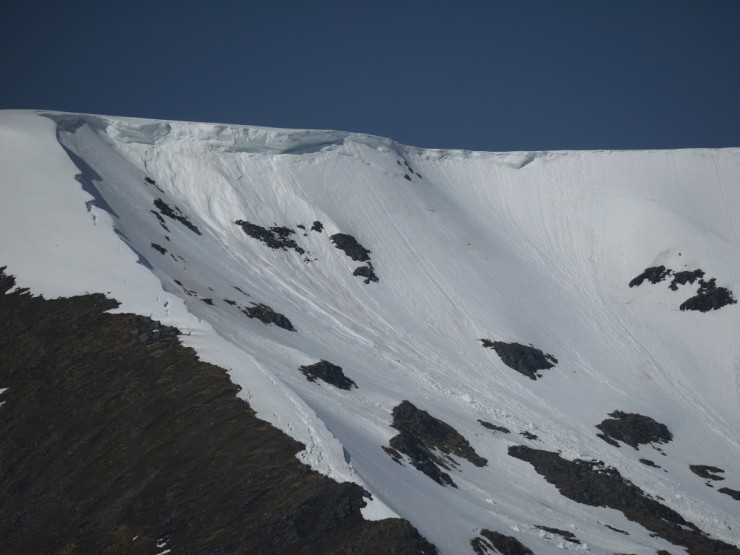
Cornices continue to collapse. More has fallen down in Coire Chriochairein but a lot remains in situ.
Very dry at Aberarder at the moment. The freshening southerly winds are kicking up ‘dust devils’ that swirl around near the farmhouse. The airborne dust in the car park made your eyes smart during gusts!
Comments on this post
Got something to say? Leave a comment
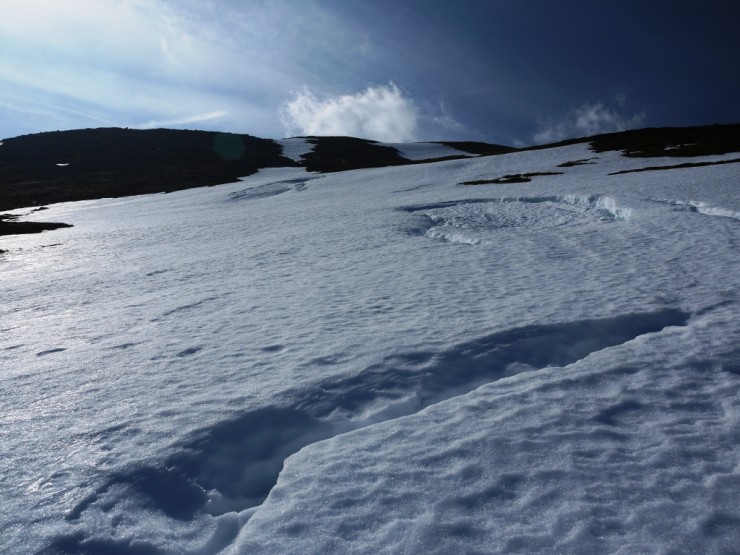
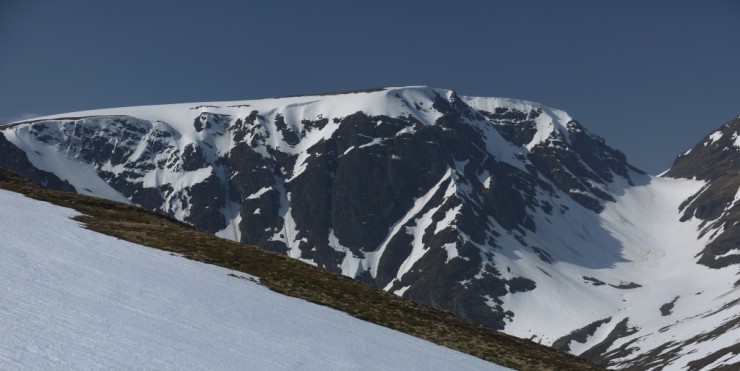
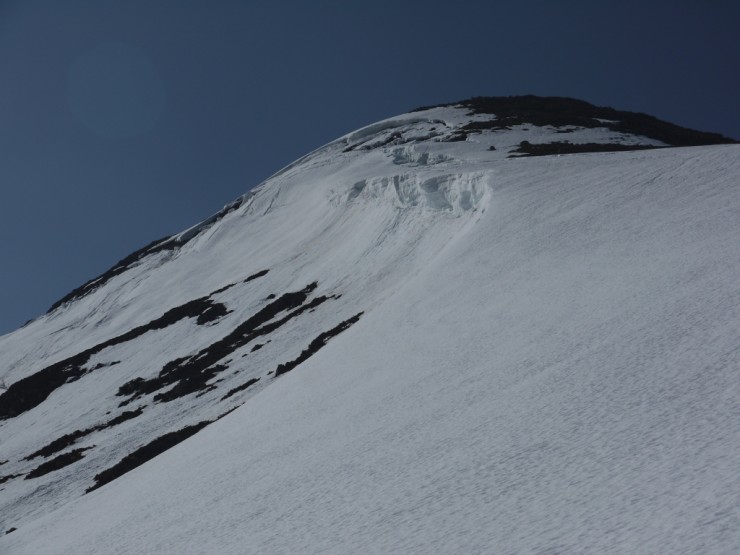

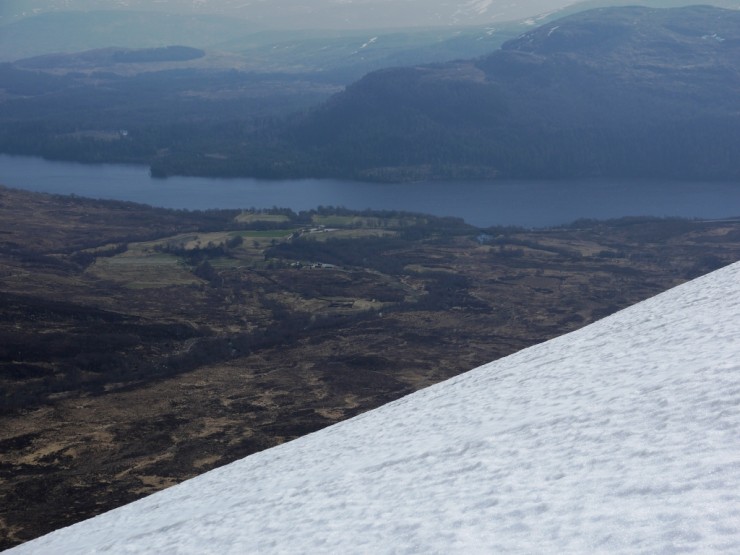




Grant Duff
9th April 2015 6:44 pm
Gosh this week “dust devils” and last week we had near blizzard conditions in the car par. I love Scotland.
Paul Pitcher
9th April 2015 9:20 pm
I made it to the top of Last Post in mid-March, saw a lot of what I believed to be ~5m long glide cracks on margins of Easy Gully pretty much right at the entrance of one of the earlier ‘posts’. Also on 3rd pitch turning the buttress of the left hand side glide cracks on probably 70deg well-consolidated snow. I personally felt from a risk perspective the cracks and surrounding pack superficially looked quite stable.
The photos in todays blog just prompted my thinking about glide cracks – they do not indicate instability of themselves – correct? This is just natural consolidation, ie a tensile failure of the pack where the pack was consolidated enough to prevent a full-on shear failure (ie slab avalanche). Would you offer some advice – what is your thought process when you see glide cracks? Is my above logic correct?
meagaidhadmin
10th April 2015 6:55 pm
Paul. An excellent and timely series of questions! I hope my answers do them justice. Get yourself a cup of tea and a biscuit because this is going to take some timeâ¦..
First a disclaimer. The physics, mechanics and forces involved in full depth wet snow avalanches are not yet fully understood by snow scientists and practitioners. The knowledge base is increasing but much more slowly than for dry snow avalanches which have better understood weak layers and release characteristics.
In general, snow with deep glide cracks on steeply inclined ground should be avoided during periods of sustained thaw or heavy rain. The presence of free water at the snow-ground interface acts as a lubricant and contributes to increased rates of snow glide, which in turn brings the snow closer to the point of shear failure at the snow ground interface.
âI made it to the top of Last Post in mid-March, saw a lot of what I believed to be ~5m long glide cracks on margins of Easy Gully pretty much right at the entrance of one of the earlier âpostsâ.â
I too have seen fairly impressive glide cracks in Easy Gully with one resembling a bergshrund some years ago. However, I have fewer worries about glide cracks in deep old snow in most Scottish gullies since the bed surface is usually highly irregular, being composed of large boulders, rocks etc.. The sides of gullies also offer additional frictional surfaces which should help mitigate mass snow glide. Open slope full depth avalanches (our most common ones) have two fewer frictional interfaces to overcome.
Having said that, there are few famous examples of gullies avalanching full depth at Creag Meagaidh – one witnessed by the SAIS Co-ordinator and I during one of our periodic CPD/verification sessions one April a few years ago! A very large chunk of ice fell onto the snow in the âhiddenâ, relatively low-angled gully/ramp near the start of Staghorn Gully. The bed-surface there is a mix of grasses, moss, gravel with some rocks but is smooth enough for full depth activity evidently. It was a sizeable trigger, during heavy thaw conditions, so not entirely surprising it slid. (We were part way up Easy Gully at the time and it certainly concentrated the mind!)
âAlso on 3rd pitch turning the buttress of the left hand side glide cracks on probably 70deg well-consolidated snow. I personally felt from a risk perspective the cracks and surrounding pack superficially looked quite stable.â
Very steep locations, similar to your example on Last Post, present additional hazard during wet/thaw conditions since how well consolidated the snow is has little bearing on the amount of water at the bed-surface, and of course the steeper gradient will act as a glide multiplier. We have several examples exactly like this in our area at the moment (the backwall of Coire nan Gall, for instance) and being anywhere near them would be hazardous in sustained thaw conditions. My guess is that since you were climbing Last Post (well known steep ice route) weather conditions had probably been very cold for some time prior to your visit (otherwise the route wouldnât have been in anything like a climbable condition?). Thus there would have been little free water around to initiate glide. Not necessarily safe, but safer than during periods of thaw.
âThe photos in todays blog just prompted my thinking about glide cracks â they do not indicate instability of themselves â correct? This is just natural consolidation, ie a tensile failure of the pack where the pack was consolidated enough to prevent a full-on shear failure (ie slab avalanche).â
I can see what youâre driving at in your last point (tensile failure relieving the possibility of shear failure) but I interpret it differently. Full depth avalanches are really about the mass movement of well consolidated, often moist or wet, dense snow. If there had been shear failure, then it probably already happened within mid-pack layers to produce the more common wet slab avalanches some time before full depth tensile failure becomes an issue.
Some additional general points:
There is some evidence that full depth avalanches can release after a re-freeze. The logic here is that the slab expands and flexes slightly as it freezes breaking bonds with the bed-surface (which is still more than likely wet if the re-freeze hasnât been prolonged).
Also, be wary of areas with glide cracks on very steep ground when the weather suddenly turns cold after a long period of thaw, since it will take sometime for the supply of bed-surface water (the source of which may be the deep overlying snowpack itself) to dry up.
Full depth avalanches fail right at the bed-surfaceâ¦full depth. Sometimes very deep wet slab avalanches can look like full depth releases but arenât because failure will have been on a deep weak layer very close to the ground. (Yes, I know, a fine distinction!)
Glide cracks can open up on snow of 20 degrees inclination or thereabouts. The snow will still glide at this angle (slowly) and if it moves over convexities on the ground glide cracks will begin to open at that point. (A bit like serac formation on a glacier but on a much more modest scale.) Differential melting of a snow covered burn can also produce similar effects. In general these are pretty benign features and one is shown in the first photo above.
âWould you offer some advice â what is your thought process when you see glide cracks?â
My own thought processes when I see glide cracks? Glide cracks can open quickly and release, or just do nothing for agesâ¦..but then suddenly release. The release isnât necessarily unexpected, itâs just that sometimes absolutely nothing happensâ¦they just keep widening and…nadaâ¦sometimes for weeks. So I give them a wide berthâ¦.alwaysâ¦because the deficit of understanding is much deeper than the sum of the current knowledge base.
Paul Pitcher
10th April 2015 10:59 pm
A very helpful and thought-provoking response. I have photographs of both the suspected glide cracks from the day. Is there any way I could share these with yourself and/or the blog for learning/discussion? Last Post was in a melting condition that day with the waterfall providing a noticeable and aubidle flow. Nevertheless it was still eminently climbable and in decent condition, although very banked out. The question I have to ask myself-was there a risk of a full depth failure while we were climbing. I need a few days and some whiskey to ponder that one!